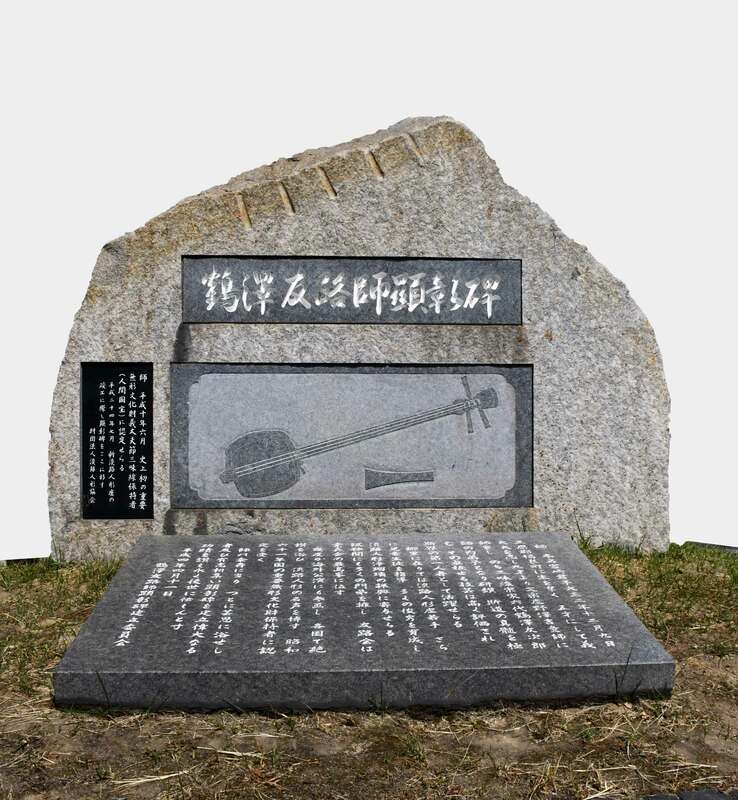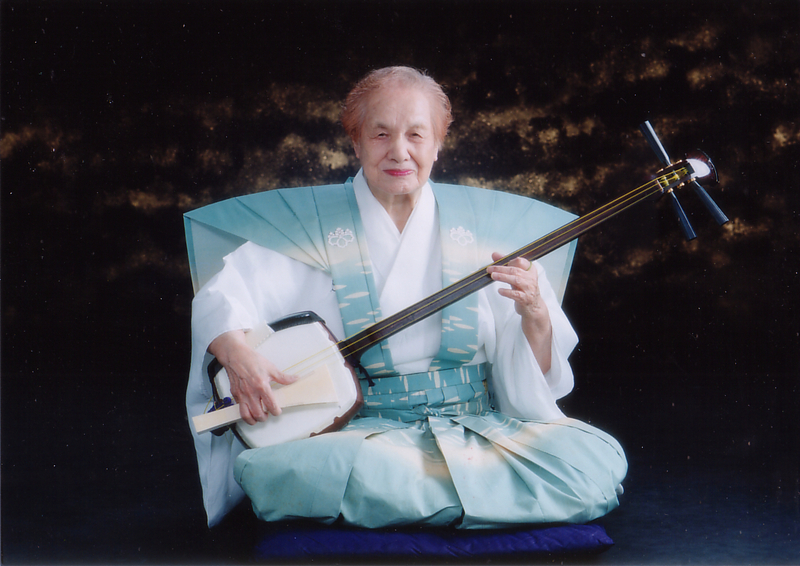Living National Treasure, the late Master Tsuruzawa Tomoji
人間国宝
故鶴澤友路師匠(2016年ご逝去)のご紹介
淡路人形座には魅力的な女性が多いのですが、技芸だけでなく、人間味あふれる世界一の演者は鶴澤友路師匠でした。国指定重要無形文化財義太夫節保持者(人間国宝)故鶴澤友路の顕彰碑の紹介文は以下です。

師 本名宮崎君子大正二年十二月九日三原郡福良町に生を享く 五才にして義太夫節を志し九才より文楽座野澤吉童師に師事し のち三味線宗家六代鶴澤友次郎師の内弟子となり研鑽 斯道の真髄を極む その卓越せる技芸は高く評価され 斯界の第一人者として活躍せらる
郷里にありては淡路人形座若手 さらに児童生徒を指導 多くの俊秀を育成し淡路人形浄瑠璃の振興に寄与せらる
阪神間にも多くの門弟を擁し 友路会は素義会の最高峰に位す
幾度か海外公演にも参画し 各国で絶賛を浴び 淡路人形の名声を博す 昭和六十一年くにの重要無形文化財保持者に認定を受く
師 傘寿に当たり つとに芸恩に浴せし者及び有志相集い顕彰碑を建立偉大なる功績を讃え永く後世に伝えんとす
平成四年四月十一日
鶴澤友路顕彰碑建立委員会
これを読むと人間国宝になるまでの努力や、義太夫節を通じての貢献が分かりますが、人間的な魅力は私たち淡路人形座の座員が一番知っています。一番弟子であり、淡路人形座の花形太夫として活躍をしてきた竹本友喜美師匠が故友路師匠の人間国宝認定時に書かれたメッセージを紹介します。
「この上ない幸せ」
人間国宝の認定を世界中で最も喜び、最も当然の結果と感じているのは私に違いありません。終戦直後の何もない時代から弟子として仕えさせていただき、厳しさの中に温かみのある指導をして下さいましたお師匠様には、常に感謝と尊敬の念を抱き続けております。鮎原での修行時代、水汲みに行った河原で遊びに夢中になり、叱られたこともありましたが、真冬の夜半に目が覚めると師匠の三味線の音が聞こえ、「何事も一所懸命やれば出来ないことはない」という言葉の裏には、人知れず努力する姿があるということに子どもながらも感動したものです。
「人間一生が勉強である」と自分自身にも厳しく、芸の追及を怠ることなく、数多くの稽古部屋を持ち、稽古に明け暮れる毎日で、修行を続けておられる姿に、泣き虫の私には涙なしでは見られないことも、しばしばありました。三味線は、状況、情景を表現しなければなりません。心を伝えるためには、単に手で弾くのではなく、足の親指に力をためて腰で弾くものです。また気持ちの上では腹がまえと呼ばれる精神統一をして押す息で弾き、太夫とこころをひとつにして息、間、『あうん』の呼吸を絶えず計っていくことが大切です。師匠の三味線で語ると、自分の力以上のものを引き出してくれるという安心感と満足感のある舞台を勤めることができます。人間国宝の弟子として、これからも尚一層、精進、努力していきたいと思っております。
淡路人形座の座員は友路師匠の芸と人生にあこがれ、三味線、語り、人形とそれぞれの分野で稽古に励んでいます。応援をお願いします。
鶴澤友路師匠の活動

後継者の育成
鶴澤友路師匠が現在までに指導した弟子は千人以上にのぼります。
竹本友喜美、竹本友庄、鶴澤友勇、鶴澤友弥、竹本友里希
後継者育成の取り組み
| 昭和15年~ | 内弟子をとる。 |
|---|---|
| 昭和46年~平成15年 | 南淡町福井子ども会人形浄瑠璃部を指導。 |
| 昭和47年~平成12年 | 三原町立市小学校(現 南あわじ市立市小学校)郷土文化部を指導。 |
| 昭和50年~平成15年 | 兵庫県立三原高等学校郷土部を指導。 |
| 昭和57年~平成18年 | 淡路人形座若手座員の指導。 |
| 昭和58年~平成15年 | 三原町立三原中学校(現 南あわじ市立三原中学校)郷土部指導。 |
| 昭和58年~平成25年 | 南淡町立南淡中学校(現 南あわじ市立南淡中学校)郷土芸能部指導。 |
海外での公演
【海外公演歴】合計11回 16カ国
| 昭和49年 | 内弟子をとる。 |
|---|---|
| 昭和53年 | 南淡町福井子ども会人形浄瑠璃部を指導。 |
| 昭和54年 | 三原町立市小学校(現 南あわじ市立市小学校)郷土文化部を指導。 |
| 昭和55年 | 兵庫県立三原高等学校郷土部を指導。 |
| 昭和59年 | 淡路人形座若手座員の指導。 |
| 昭和61年 | 三原町立三原中学校(現 南あわじ市立三原中学校)郷土部指導。 |
| 昭和62年 | 南淡町立南淡中学校(現 南あわじ市立南淡中学校)郷土芸能部指導。 |
| 平成4年 | スペイン・ドイツ・ポーランド |
| 平成6年 | チェコ・ルーマニア・ハンガリー・ブルガリア・ポーランド |
| 平成9年 | フランス |
鶴澤友路師 経歴紹介
プロフィール
本名 宮崎 君子
生年月日 大正2年12月9日
南淡町福良乙280番地3において、父 善吉、母 かつの五女として誕生。
四歳 野澤吉鳳師に師事し、「傾城阿波の鳴門順礼歌の段」を語る。
五歳から豊澤徳八師に師事し、一門の興行で看板娘となり、上村源之丞座、市村六之丞座、吉田傅次郎座の巡業で各地の舞台に立つ。
野澤吉童師、竹本東廣師、豊澤廣助師に師事。
経歴年表
| 昭和8年 | ラジオ徳島放送に出演。以後各局のラジオ・テレビ番組に出演。 |
|---|---|
| 昭和11年 | 三味線界の宗家 鶴澤友次郎師、野澤吉弥師、竹本染登師、鶴澤寛治師、竹本綱大夫師ら後の人間国宝の方々の教えを受ける。 |
| 昭和15年~ | 内弟子をとり後継者育成に努める。 |
| 昭和16年 | 宗家より鶴澤友路の芸名をいただく。 |
| 昭和23年 | 福良にて披露公演。 |
| 昭和26年 | 四橋文楽座にて竹本三蝶・染登の相三味を務め、以後、宝塚大劇場、京都南座、大阪朝日座、大阪三越劇場、東京国立劇場等で当時の第一人者の相三味を務める。 |
| 昭和28年 | 弟子の会「友路会」を結成。以後、淡路素義審査会、日本素義振興会審査会にて団体優勝をかさね、幾多の横綱を輩出。 |
| 昭和38年 | 兵庫県知事表彰受賞。 |
| 昭和47年 | 平成天皇皇后陛下に芝居を上覧にいれる。 |
| 昭和49年 | 日本顕彰会表彰受賞。 |
| 同年 | カーネギーホールをはじめとするアメリカ公演に参加。 世界十六ヶ国で公演。国際交流・親善に尽力する。 |
| 昭和59年 | 芸能団体「半どんの会」表彰受賞。 |
| 昭和60年 | 兵庫県文化賞受賞。 |
| 同年 | 木杯(五号)を授与される。 |
| 昭和61年 | 重要無形文化財義太夫節(総合指定)の保持者に認定される。 |
| 昭和61年~ | 人間国宝 竹本土佐廣師の相三味を務める。 |
| 平成4年 | 有志により大鳴門橋記念館脇に顕彰碑が建立される。 |
| 平成7年 | 文化庁長官表彰受賞。 |
| 平成8年 | 伝統文化ポーラ賞特賞受賞。 |
| 平成10年 | 重要無形文化財義太夫節三味線保持者に認定される。 |
| 平成28年12月 | 103歳でご逝去されました。 |
エピソード
才能開花のきっかけ
四歳のころ傾城阿波の鳴門順礼歌の段を語り大人を驚かせました。
自宅が浄瑠璃の稽古部屋だったので門前の小僧のように語りを憶え、上手に語ったのが才能を開花させるきっかけとなりました。
やんちゃな子供時代
小さい頃はやんちゃで、遊び相手は男の子ばかり。近所の子どもと遊んでいて次々に新しい友達に付いていき、夕方になると自分がどこにいるかわからなくなって、賀集で隣人に発見され、連れてもどられてからは迷子札をつけられていました。また、父親に叱られたので、父親が屋根に上った隙に梯子を隠し、大目玉を食ったこともあります。
木登りをして墜落し、目を開けたら母親が泣いていて、親を泣かしてはいけないと気づいたそうです。
修行時代の思い出
大阪で修行中、お使いに行くたびに回転焼きを食べている人や匂いが気になっていた友路師匠。我慢できずに買い、持って帰ったものの食べる場所がなく、トイレに入って食べたことがあるのだとか。
